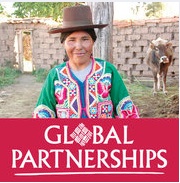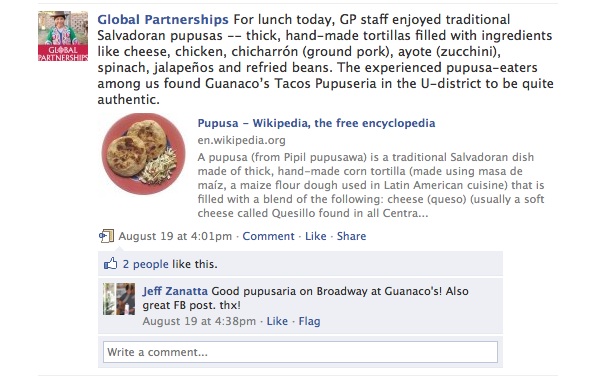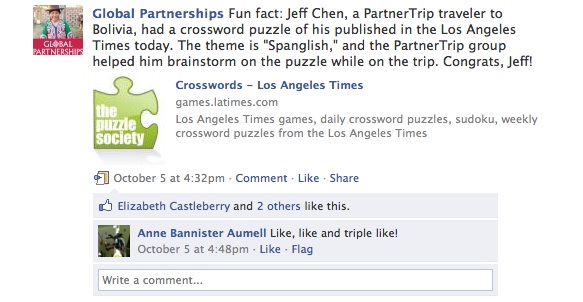 Global Partnerships (GP), a Seattle-based nonprofit, expands opportunity for people living in poverty by supporting microfinance and other sustainable solutions in Latin America. They partner with innovative, mission-driven microfinance institutions that reach people traditionally left behind—such as women and the rural poor—with microloans and other services that can help families break the cycle of poverty.
Global Partnerships (GP), a Seattle-based nonprofit, expands opportunity for people living in poverty by supporting microfinance and other sustainable solutions in Latin America. They partner with innovative, mission-driven microfinance institutions that reach people traditionally left behind—such as women and the rural poor—with microloans and other services that can help families break the cycle of poverty.
They are a shining example of a nonprofit that knows how to deeply engage with people who care about their mission. In recent years, they’ve integrated social media into their marketing mix–with excellent results. We recently sat down with Elisa Murray, Director of Communications, and Chris Megargee, Director of Community & Corporate Relations, to learn more about their experience navigating the social media waters.
How did GP get started with social media? Global Partnerships works in Latin America, far, far away from where their supporters live. This makes it hard to get a sense for the impact their partners have on the lives of those they serve. A few GP supporters go on PartnerTrips but most don’t have the opportunity to see the work first-hand. Knowing how much the PartnerTrips mean to those who did have a chance to go, GP was inspired to explore ways for supporters to be able to have that experience while staying local via photos and videos. They wanted to share their great videos and photos from these trips abroad, as well as local events like the awesomely successful Business of Hope Luncheon. (‘Awesomely’ is our word, not theirs, by the way.)
It was 2008 and they had a website with loads of great information but it was time consuming to update and fairly static. One day, they attended an NDOA event where they learned from nonprofiteers who were dipping their toes in social media. It was there they realized that social media might be a great way to connect supporters with their work on the ground.
They went back to the office and signed up for personal Facebook accounts. This was before we had Facebook Pages like we have today, so they experimented with Facebook Groups and a Facebook Causes page. Eventually, they created a Global Partnerships Facebook Page, which turned out to be a perfect fit with their overall communications strategy.
The Results? They have measured their website visits since launching the Facebook page and their website visits have gone significantly up, an excellent sign that they’re achieving their goal.
Advice from GP
- Identify your goal and your audience before the tool. They knew they wanted 1) to deepen their relationship with current supporters who couldn’t travel and 2) to reach out to women and younger people interested in improving the lives of women in South America. Facebook was a logical place to engage with their target audiences since they are already active Facebook users.
- Start by focusing on one tool and doing it well enough to make it worth it. Of all of their time spent on communications and outreach, they have the resources to spend only 5-10% on social media–a fairly common situation for nonprofits. Pick one and go with it.
- Just say ‘no’. Over the past couple of years, they were tempted to start a blog but realized that they didn’t have enough resources to do a blog well at the moment. Based on their goals and their capacity at this point in time, they decided to say no to a blog.
- Say ‘thank you’. Facebook is a great way to thank volunteers.

- Be human. Your supporters don’t want to know about every latte run you go on, but sometimes sharing what you had for lunch make sense. People engage with people, so don’t be afraid of being human.

- Change it up: Adding variety and focusing on those outside your organization keeps your page lively and interesting.

- Master your message: Make sure your messaging is consistent with other communications. Supporters should come away with the same impression of the organization whether they come across you on-line or on-land.
Many thanks to Global Partnership for sharing how they’ve gone social without going crazy!
Do you have a social media success story to share?
 In our excitement about selling out of our first batch of Pitchfalls: Why Bad Pitches Happen to Good People, we decided to give away the first copy of the second batch for free. You may have seen us tweeting like crazy last week to let you all know about it. To decide the lucky winner, we randomly chose one of our Facebook followers. We’re happy to announce that the winner is…..
In our excitement about selling out of our first batch of Pitchfalls: Why Bad Pitches Happen to Good People, we decided to give away the first copy of the second batch for free. You may have seen us tweeting like crazy last week to let you all know about it. To decide the lucky winner, we randomly chose one of our Facebook followers. We’re happy to announce that the winner is…..



 Integrating social media into your marketing mix can be daunting. So many options, so little time! In an effort to save you time and keep you sane, we’ve created the following six step process and actionable item checklists for the most popular tools.
Integrating social media into your marketing mix can be daunting. So many options, so little time! In an effort to save you time and keep you sane, we’ve created the following six step process and actionable item checklists for the most popular tools.